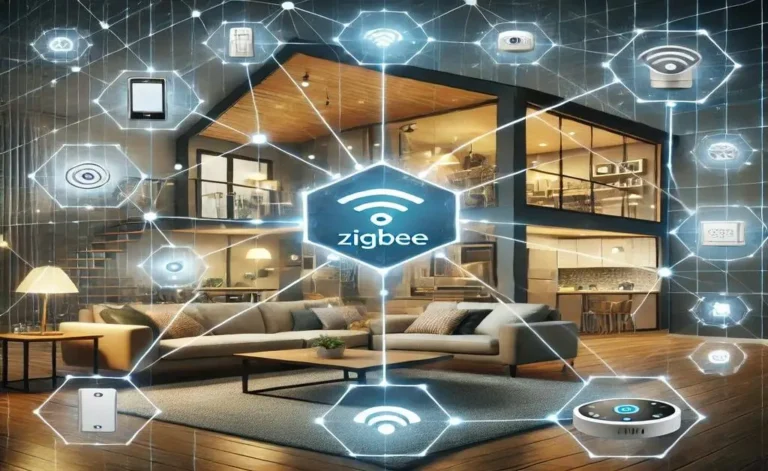What is Zigbee?
Imagine walking into your home, and your smart lights automatically turn on. Your thermostat adjusts to the perfect temperature, and your security system arms itself without lifting a finger. This seamless experience is possible because of Zigbee, a wireless communication protocol designed specifically for smart home automation and the Internet of Things (IoT).
Unlike WiFi or Bluetooth, Zigbee is built for low-power, energy-efficient communication between smart devices. Whether you’re looking to upgrade your home security, automate lighting, or integrate voice control, Zigbee devices provide reliable and responsive connectivity.
How Does the Zigbee Protocol Work?
The Zigbee protocol operates on a mesh network, which means all connected devices communicate with each other to ensure a strong and stable connection. Unlike WiFi, where all devices connect to a single router, Zigbee-enabled gadgets create a web of connections that improve network reliability and range.
Zigbee Network Topology: How Devices Connect
Zigbee networks typically consist of three main components:
- Zigbee Coordinator: The central hub that manages network traffic and connects to other systems.
- Zigbee Routers: Devices that extend the network range by passing signals to other devices.
- Zigbee End Devices: Low-power gadgets like sensors and light bulbs that connect to routers or the coordinator.
This structure ensures that even if one device goes offline, the network remains functional, making Zigbee home automation a reliable choice for smart homes.
Zigbee vs WiFi: Which is Better for Smart Homes?
When it comes to Zigbee vs WiFi, each has its strengths and weaknesses. Let’s break it down:
| Feature | Zigbee | WiFi |
|---|---|---|
| Power Consumption | Low | High |
| Network Type | Mesh | Star (Single Router) |
| Range | 10-100m | Varies (Depends on Router) |
| Interference | Low | High (Due to congestion) |
| Security | Strong encryption | Standard encryption |
| Scalability | High (Supports hundreds of devices) | Moderate |
For a smart home, Zigbee is often the better choice because it consumes less power, supports more devices, and avoids WiFi congestion.
Zigbee Applications: Where is It Used?
The Zigbee technology is widely used across different industries, including:
- Smart Lighting: Control Zigbee smart lights with voice commands or automation.
- Home Security: Sensors, door locks, and security cameras use Zigbee for instant alerts.
- Energy Management: Smart thermostats and energy monitors optimize power usage.
- Industrial Automation: Factories use Zigbee for wireless sensor networks and monitoring systems.
- Healthcare: Medical devices and wearables rely on Zigbee for efficient data transmission.
Building a Zigbee Smart Home: A Step-by-Step Guide
Ready to set up your Zigbee smart home? Follow these steps:
Step 1: Choose a Zigbee Hub
A Zigbee hub acts as the brain of your smart home. Popular options include:
- Amazon Echo with Zigbee (Built-in hub)
- Samsung SmartThings Hub
- Hubitat Elevation
- Aqara Hub
Step 2: Select Compatible Zigbee Devices
Make sure your devices are Zigbee-compatible. Some popular categories include:
- Zigbee smart lights (Philips Hue, Sengled)
- Zigbee sensors (Motion, temperature, door/window sensors)
- Zigbee locks (Yale, Schlage)
- Zigbee thermostats (Ecobee, Hive)
Step 3: Connect and Automate
- Pair your devices with the Zigbee coordinator (Hub)
- Set up automation rules (e.g., turn off lights when leaving home)
- Integrate with voice assistants like Alexa or Google Assistant
Zigbee Security: Is It Safe?
Security is a common concern for smart home users. Fortunately, Zigbee security is robust, featuring:
- AES-128 Encryption: Protects data from hackers.
- Secure Key Exchange: Prevents unauthorized access.
- Device Authentication: Ensures only trusted devices connect.
Zigbee vs Z-Wave: What’s the Difference?
Another popular alternative is Z-Wave. Here’s how they compare:
| Feature | Zigbee | Z-Wave |
| Frequency | 2.4GHz | 900MHz |
| Max Devices | 65,000+ | 232 |
| Range | 10-100m | 30-100m |
| Interference | Moderate | Low |
| Compatibility | High | Moderate |
Both are excellent for home automation, but Zigbee supports more devices and is widely used in commercial applications.
Best Zigbee Products to Buy in 2025
Looking to buy the best Zigbee products? Here are top recommendations:
- Best Zigbee Smart Lights: Philips Hue, Sengled
- Best Zigbee Hub: SmartThings, Hubitat
- Best Zigbee Smart Lock: Yale Assure Lock
- Best Zigbee Sensor: Aqara Motion Sensor
FAQs About Zigbee
1. What is the range of Zigbee?
Zigbee range typically covers 10-100 meters indoors, but its mesh network extends coverage.
2. Do I need a Zigbee hub?
Yes, most Zigbee devices require a hub to communicate and work together.
3. Is Zigbee better than WiFi?
For smart home automation, Zigbee is superior due to low power consumption and network efficiency.
4. Can Zigbee work without the internet?
Yes, Zigbee operates locally, making it more reliable than WiFi-based smart devices.
5. What is a Zigbee module?
A Zigbee module is a small chip used to enable wireless communication in smart devices.
With Zigbee technology, you can build a reliable, efficient, and secure smart home ecosystem. Whether upgrading your lighting, security, or energy management, Zigbee ensures seamless automation with minimal effort. Ready to start your Zigbee home automation journey? Choose the best Zigbee hub and devices today!



